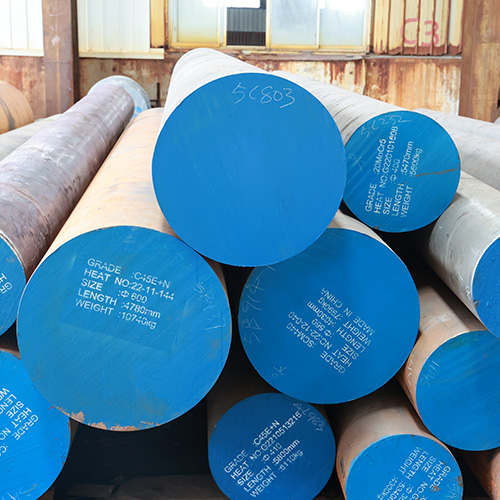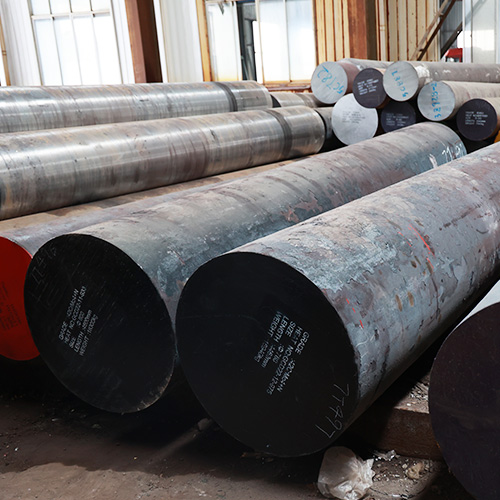Introduction

In the realm of modern architecture, materials play a pivotal role in shaping both aesthetics and functionality. Among these materials, special steel stands out as a fundamental component that drives innovation and sustainability. This blog delves into the importance of this material in contemporary architectural practices, examining its properties, applications, and benefits while highlighting its critical role in ensuring structural integrity and design flexibility. As the demands for higher performance and environmental considerations grow, special steel is increasingly recognized as an essential choice for architects and engineers alike.
What is Special Steel?
Special steel refers to a category of steel that has been engineered to possess unique properties tailored for specific applications. Unlike standard steel, this material is designed to meet rigorous performance standards, often including enhanced strength, corrosion resistance, and durability. This makes it a preferred choice for many high-performance applications in architecture. Common types include stainless steel, high-strength low-alloy (HSLA) steel, and weathering steel, each chosen for its unique attributes that contribute to modern design needs.
| Type of Special Steel | Key Properties | Common Applications |
|---|---|---|
| Stainless Steel | Corrosion resistance, aesthetic appeal | Facades, structural elements |
| HSLA Steel | High strength-to-weight ratio | Bridges, high-rise buildings |
| Weathering Steel | Oxidation resistance, maintenance-free | Outdoor sculptures, bridges |
Each type serves distinct purposes, allowing architects to select the most suitable material based on the specific demands of their projects. Understanding these materials is crucial for leveraging their advantages effectively in architectural design.
The Properties of Special Steel
Strength and Durability
One of the most significant advantages of this material is its exceptional strength and durability. These properties enable architects to design structures that can withstand extreme environmental conditions while minimizing the amount of material needed. For instance, buildings located in seismic zones often require materials that can absorb and dissipate energy, making special steel a popular choice. The ability to create slender, lightweight structures without compromising on strength has revolutionized modern architecture, allowing for larger spans and more open spaces.
Corrosion Resistance
Corrosion resistance is vital for materials exposed to harsh weather or chemical environments. Special steel, particularly stainless steel, offers superior protection against rust and degradation, ensuring longevity and reducing maintenance costs. This is especially important for coastal buildings, where saltwater can rapidly corrode conventional materials. By utilizing special steel, architects can extend the lifespan of structures, providing not only aesthetic benefits but also practical longevity that leads to cost savings over time.
Aesthetic Versatility
Architects increasingly turn to this material for its aesthetic flexibility. With various finishes and textures available, special steel can contribute to striking visual elements, enhancing the overall architectural design. Whether polished for a sleek modern look or treated for a rustic appearance, this material can fit a wide range of design philosophies. This versatility allows architects to create iconic buildings that are not only functional but also memorable.
Applications of Special Steel in Modern Architecture
Structural Components
Special steel is widely used in structural components, providing the necessary strength for beams, columns, and frameworks. This usage not only ensures safety but also allows for more open and flexible interior designs. For instance, in high-rise buildings, this material enables larger floor plates with fewer columns, facilitating creative layouts and maximizing usable space. The strength-to-weight ratio also contributes to lighter structures, reducing the overall load on foundations and allowing for innovative designs.
Facades and Cladding
The use of this material in facades offers both aesthetic appeal and functional benefits. Stainless steel cladding not only enhances the visual impact of a building but also protects it from the elements. The reflective properties can create stunning light effects, while weathering steel develops a protective patina that blends with the environment over time. This dual functionality allows architects to achieve both beauty and resilience in their designs, making special steel a popular choice for facades worldwide.
Innovative Designs
With advancements in manufacturing techniques, this material enables architects to explore innovative designs. The high strength-to-weight ratio allows for complex shapes and structures that would be impossible with conventional materials. For example, special steel has been used in creating intricate lattice structures and sculptural forms that challenge traditional architectural norms. As architects push the boundaries of design, this material becomes an indispensable tool for realizing their visions.
Benefits of Using Special Steel
Sustainability
The sustainability of special steel is a key factor in its growing popularity. Many types are recyclable and can contribute to a building’s overall sustainability goals, aligning with modern architectural trends towards eco-friendly practices. By choosing this material, architects not only contribute to reducing waste but also often benefit from government incentives aimed at promoting sustainable building practices. This environmentally conscious approach is becoming increasingly important in today’s construction industry.
Cost-Effectiveness
While the initial cost of special steel may be higher than standard steel, its longevity and reduced maintenance needs often result in lower overall costs. This cost-effectiveness makes it a smart choice for modern architectural projects. Over time, the durability can translate into significant savings, as fewer repairs and replacements are needed. When life-cycle costs are considered, this material frequently emerges as the more economical option for both builders and owners.
Safety and Compliance
Using this material helps ensure compliance with safety regulations and building codes. The strength and reliability contribute to the overall safety of the structure, making it an essential choice for architects and builders. For instance, special steel can meet or exceed the requirements for wind load, seismic activity, and fire resistance, providing peace of mind for architects as they design buildings intended to protect the lives of their occupants.
Challenges in Using Special Steel
Availability and Sourcing
One challenge architects may face is the availability of specific types of special steel. Sourcing quality materials can sometimes lead to delays in construction schedules, impacting project timelines. Architects must work closely with suppliers to ensure that the required materials are available when needed. This may involve strategic planning and coordination to prevent any disruption in the construction process.
Cost Implications
While this material offers numerous benefits, the higher upfront costs can deter some projects from utilizing it. However, when considering the long-term benefits, many find the investment worthwhile. Educating clients about the advantages can help mitigate concerns about initial expenses and encourage smarter decisions that prioritize quality and sustainability.
Fabrication and Installation
The fabrication and installation of special steel can require specialized skills and equipment. This necessity can add complexity to the construction process, making careful planning essential. Architects and builders must ensure that their teams are adequately trained and equipped to handle this material, as improper handling can negate its benefits and lead to costly mistakes.
Case Studies: Special Steel in Iconic Structures
The Burj Khalifa
The Burj Khalifa, the tallest building in the world, utilizes high-strength special steel to achieve its iconic height and stability. The framework provides the necessary strength while allowing for an elegant design that has become a global symbol of architectural excellence. The careful selection of this material allowed the project to meet stringent safety standards while pushing the limits of what was previously thought possible in skyscraper design.
The Guggenheim Museum Bilbao
The Guggenheim Museum in Bilbao showcases the aesthetic possibilities of special steel. Its unique curves and forms are made possible through the use of weathering steel, demonstrating how material choice can enhance architectural vision. This choice not only supports the structural integrity of the building but also adds to its artistic narrative, making the museum a landmark in contemporary architecture.
| Structure | Type of Special Steel | Key Features |
|---|---|---|
| Burj Khalifa | High-strength steel | Skyscraper stability, design flexibility |
| Guggenheim Museum Bilbao | Weathering steel | Aesthetic appeal, unique forms |
These case studies exemplify the diverse applications and benefits of this material, illustrating its critical role in modern architecture.
Future Trends in Special Steel and Architecture

Smart Special Steel
As technology advances, the future of this material may involve smart materials that adapt to environmental conditions. This evolution will lead to even more innovative architectural solutions. Imagine buildings that can self-repair or adjust their properties based on temperature or humidity, significantly enhancing energy efficiency and comfort for occupants.
Increased Sustainability
With a global focus on sustainability, future applications will likely prioritize eco-friendly practices. This shift will encourage architects to adopt materials that contribute to a greener future. The recyclability of special steel, combined with the industry’s efforts to reduce carbon footprints, positions it as a key player in the development of sustainable architecture.
Conclusion
In conclusion, special steel is an indispensable material in modern architecture. Its unique properties offer architects the ability to create innovative, durable, and aesthetically pleasing structures. As the industry continues to evolve, the role of this material will only become more significant, paving the way for future architectural advancements. The integration of special steel into design not only enhances structural integrity but also enables architects to realize their creative visions, ultimately shaping the skylines of tomorrow.
FAQ
Q:What types of special steel are commonly used in architecture?
A:Common types include stainless steel, high-strength low-alloy steel, and weathering steel, each with distinct properties and applications. Understanding these types helps architects choose the best material for specific projects.
Q:Why is special steel more expensive than regular steel?
A:This material often involves advanced manufacturing processes and materials that enhance its properties, resulting in higher costs, but long-term savings on maintenance and durability often justify this initial investment.
Q:Can special steel be recycled?
A:Yes, most types are recyclable, making them a sustainable choice for modern architecture. This property not only reduces waste but also supports the circular economy in construction.
Q:What is the role of special steel in sustainability?
A:Special steel contributes to sustainability through its durability, reduced maintenance needs, and recyclability, aligning with modern eco-friendly practices and helping architects meet their environmental goals.
Q:How does this material enhance architectural design?
A:Special steel allows for greater design flexibility, enabling architects to create unique shapes and structures that are both functional and visually striking. Its versatility makes it a favored choice for many innovative designs.
Q:Are there any challenges in using special steel?
A:Challenges include sourcing availability, higher upfront costs, and the need for specialized skills for fabrication and installation. Architects must carefully plan to mitigate these issues and ensure successful project execution.
Q:What are some iconic buildings that use special steel?
A:Notable examples include the Burj Khalifa and the Guggenheim Museum Bilbao, both of which showcase the benefits of this material in architecture and highlight its potential for both structural performance and aesthetic appeal.
